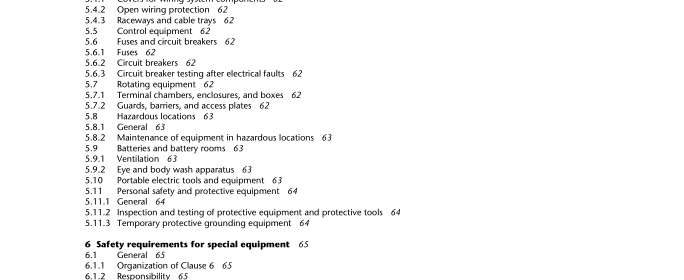CSA Z462-12 pdf download – Workplace electrical safety.
3 Definitions The following definitions apply in this Standard: Accessible (as applied to equipment) — admitting close approach because the equipment is not guarded by locked doors, elevation, or other effective means. Accessible (as applied to wiring methods) — not permanently closed in by the structure or finish of the building, and capable of being removed without disturbing the structure or finish. Ampacity — the current, in amperes, that a conductor can carry continuously under the conditions of use without exceeding its temperature rating. Approved — acceptable to the authority having jurisdiction. Approved (as applied to electrical equipment) — equipment that (a) has been certified by a certification organization accredited by the Standards Council of Canada in accordance with the requirements of (i) CSA Standards; or (ii) other recognized documents, where such CSA Standards do not exist or are not applicable; or (b) conforms to the requirements of the regulatory authority. Note: In Canada, accreditation of certification organizations is provided by the Standards Council of Canada. Arc flash hazard — a dangerous condition associated with the possible release of energy caused by an electric arc.
Notes: (1) An arc flash hazard can exist when energized electrical conductors or circuit parts are exposed or are within equipment in a guarded or enclosed condition, if a person is interacting with the equipment in a manner that could cause an electric arc. Under normal operating conditions, enclosed energized equipment that has been properly installed and maintained is not likely to pose an arc flash hazard. (2) See Tables 4A and 4B for examples of activities that could pose an arc flash hazard. Arc flash hazard analysis — a study investigating a worker’s potential exposure to arc flash energy, conducted for the purpose of injury prevention and the determination of safe work practices, arc flash boundary, and the appropriate levels of personal protective equipment. Arc flash suit — a complete arc-rated clothing and equipment system that covers the entire body except for the hands and feet. Note: An arc flash suit may include pants or overalls, jacket, or a coverall and beekeeper-type hood fitted with a face shield. Arc rating — the value attributed to materials that describes their performance on exposure to an electrical arc discharge. Notes: (1) The arc rating is expressed in cal/cm 2 and is derived from the determined value of the arc thermal performance value (ATPV) or energy of breakopen threshold (E BT ) (if a material system exhibits a breakopen response below the ATPV value). Arc rating is reported as either ATPV or E BT , whichever is the lower value. (2) Arc-rated clothing or equipment indicates that it has been tested for exposure to an electric arc. Flame-resistant (FR) clothing without an arc rating has not been tested for exposure to an electric arc. Arc thermal performance value (ATPV) — in arc testing, the incident energy on a material or a multi-layer system of materials that results in a 50% probability that sufficient heat transfer through the tested specimen is predicted to cause the onset of a second-degree skin burn injury based on the Stoll curve, cal/cm 2 .
Attachment plug (plug cap) (plug) — a device that, by insertion in a receptacle, establishes a connection between the conductors of the attached flexible cord and the conductors connected permanently to the receptacle. Authority having jurisdiction — an organization, office, or individual responsible for enforcing regulations or the requirements of a code or standard, or for approving equipment, materials, an installation, or a procedure. Note: The phrase “authority having jurisdiction” is used in a broad manner, since jurisdictions and approval agencies vary, as do their responsibilities. Where public safety is primary, the authority having jurisdiction can be a federal, provincial, territorial, local, or other regional department or individual, e.g., a fire chief; fire marshal; chief of a fire prevention bureau, labour department, or health department; building official; electrical inspector; or other person having statutory authority. Automatic — performing a function without the necessity of human intervention. Balaclava (sock hood) — an arc-rated hood that protects the neck and head, except for the area of the eyes and nose. Bare-hand work — a technique of performing work on energized electrical conductors or circuit parts, after the worker has been raised to the potential of the conductor or circuit part. Barricade — a physical obstruction, e.g., tape, cones, or an A-frame-type wood or metal structure, intended to provide a warning about and to limit access to a hazardous area. Barrier — a physical obstruction that is intended to prevent contact with equipment or energized electrical conductors and circuit parts or to prevent unauthorized access to a work area. Battery — a system consisting of two or more electrochemical cells connected in series or parallel that is capable of storing the electric energy received, and returning such energy by reconversion. Battery effect — a voltage that exists on the cell line after the power supply is disconnected.CSA Z462-12 pdf download.
